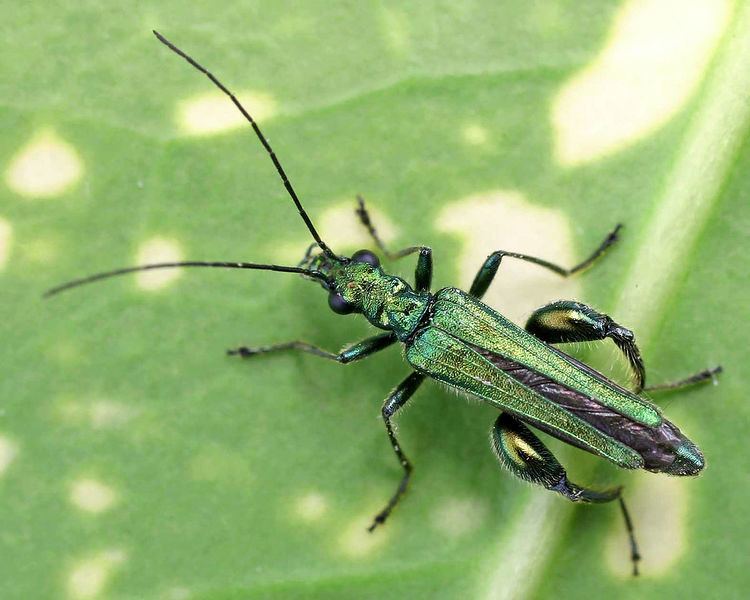Entomologia Carniolica exhibens insecta Carnioliae indigena et distributa in ordines, genera, species, varietates is a taxonomic work by Giovanni Antonio Scopoli, published in Vienna in 1763. As well as describing hundreds of new species, Entomologia Carniolica contained observations on the species' biology, including the first published account of queen bees mating outside the hive.
In contrast to his predecessors Carl Linnaeus and Johan Christian Fabricius, who had used the structure of the insect wing and the structure of the insect mouthparts, respectively, as the main means of classifying arthropods, Scopoli favoured a more holistic approach.
In Entomologia Carniolica, Scopoli described 1153 species of "insects" (a term which at that time included many arthropods), divided into seven orders:
Coleoptera (
beetles and
orthopteroid insects) – species 1–329
Proboscidea (=
Hemiptera) – species 330–418
Lepidoptera – species 419–676
Neuroptera – species 677–712
Aculeata (=
Hymenoptera) – species 713–838
Halterata (= Diptera) – species 839–1024
Pedestria (various wingless animals, including
silverfish,
fleas,
mites,
arachnids,
crustaceans and myriapods) – species 1025–1153
The animals described in Entomologia Carniolica were found in the Duchy of Carniola (also called the Krain), an area at that time under the control of the Austro-Hungarian Empire. Nowadays, it is the western part of Slovenia.
For each species, Scopoli gave references to previously published illustrations and binomial names. Few works using binomial nomenclature had appeared by 1763; those cited by Scopoli include the 10th edition of Systema Naturae (1758) and Fauna Suecica (1761) by Carl Linnaeus, and Insecta Musei Graecensis (1761) by Nikolaus Poda von Neuhaus. More than half of the species listed by Scopoli in Entomologia Carniolica were described as new. They include:
15. Scarabæus eremita, now Osmoderma eremita65. Curculio piger, now Cleonus piger97. Curculio glaucus, now Phyllobius glaucus112. Attelabus lilii, now Lilioceris lilii124. Cantharis fulva, now Rhagonycha fulva146. Cantharis nobilis, now Oedemera nobilis199. Buprestis salicina, now Smaragdina salicina264. Carabus catenulatus408. Aphis fabae428. Papilio fagi, now Hipparchia fagi510. Phalaena fulminea, now Catocala fulminea525. Phalaena rubiginosa, now Conistra rubiginosa526. Phalaena clavipalpis, now Paradrina clavipalpis527. Phalaena deceptoria, now Deltote deceptoria532. Phalaena nebulata, now Euchoeca nebulata535. Phalaena fimbrialis, now Thalera fimbrialis537. Phalaena punctinalis, now Hypomecis punctinalis540. Phalaena lineata, now Siona lineata542. Phalaena exanthemata, now Cabera exanthemata545. Phalaena ornata, now Scopula ornata546. Phalaena sylvata, now Abraxas sylvata549. Phalaena glaucata, now Cilix glaucata551. Phalaena chlorosata, now Petrophora chlorosata561. Phalaena moeniata, now Scotopteryx moeniata565. Phalaena aurata, now Pyrausta aurata567. Phalaena ochrata, now Idaea ochrata571. Phalaena alpinata, now Glacies alpinata572. Phalaena murinata, now Minoa murinata575. Phalaena laevigata, now Idaea laevigata576. Phalaena inquinata, now Idaea inquinata577. Phalaena tenebrata, now Panemeria tenebrata579. Phalaena despicata, now Pyrausta despicata580. Phalaena nigrata, now Pyrausta nigrata583. Phalaena podana, now Archips podana591. Phalaena rufana, now Celypha rufana595. Phalaena montana, now Macrophya montana599. Phalaena formosana, now Enarmonia formosana600. Phalaena rivulana, now Celypha rivulana607. Phalaena anthracinalis, now Euplocamus anthracinalis609. Phalaena citrinalis, now Hypercallia citrinalis610. Phalaena trabealis, now Emmelia trabealis612. Phalaena lunalis, now Zanclognatha lunalis614. Phalaena extimalis, now Evergestis extimalis615. Phalaena sericealis, now Rivula sericealis616. Phalaena ruralis, now Pleuroptya ruralis618. Phalaena nemoralis, now Agrotera nemoralis620. Phalaena perlella, now Crambus perlella627. Phalaena craterella, now Chrysocrambus craterellus628. Phalaena chrysonuchella, now Thisanotia chrysonuchella636. Phalaena palliatella, now Eilema palliatella638. Phalaena forficella, now Harpella forficella643. Phalaena mucronella, now Ypsolopha mucronella649. Phalaena rufimitrella, now Cauchas rufimitrella654. Phalaena scalella, now Pseudotelphusa scalella660. Phalaena aruncella, now Micropterix aruncella661. Phalaena alchimiella, now Caloptilia alchimiella662. Phalaena aureatella, now Micropterix aureatella673. Phalaena bipunctidactyla, now Stenoptilia bipunctidactyla734. Tenthredo ribesii, now Nematus ribesii819. Apis pascuorum, now Bombus pascuorum833. Formica vaga, now Camponotus vagus870. Musca maculata, now Graphomya maculata876. Musca tuguriorum, now Phaonia tuguriorum880. Musca angelicae, now Phaonia angelicae954. Conops pertinax, now Eristalis pertinax962. Conops cuprea, now Ferdinandea cuprea967. Conops aeneus, now Eristalinus aeneus1134. Oniscus muscorum, now Philoscia muscorumEntomologia Carniolica was published by Johann Thomas von Trattner in Vienna in 1763. Forty-three plates of illustrations were prepared for publication, but were never offered for sale, and few copies of Entomologia Carniolica include the plates. They illustrate the species numbered 1–815, with the exception of the genus Aphis (species 396–410).
Entomologia Carniolica was published long before the international standardisation of units; to help readers understand his measurements, Scopoli therefore included a printed scale of three Parisian inches, each divided into twelve lines. His inch was approximately 26.5 millimetres (1.04 in) long, making each line approximately 2.2 mm (0.087 in).

